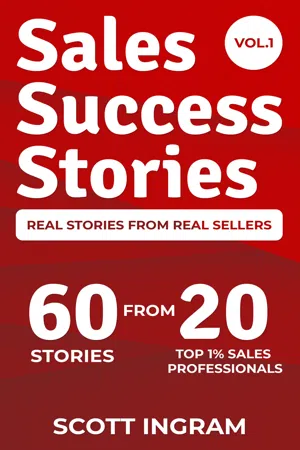
- English
- ePUB (mobile friendly)
- Available on iOS & Android
About This Book
In the first of its kind, this book features real stories of success and failure exclusively from quota carrying sales professionals who were either #1 or at least in the top 1% of sellers at their respective companies. Every contributor has been featured on Scott Ingram's Sales Success Stories Podcast.
Read about how they manage their mindset to get to and stay at the top. Learn how they develop relationships that allow them to win again and again. Benefit from their insights on how they've successfully navigated their sales careers. The book wouldn't be complete without a deep dive into their sales processes from prospecting and discovery to territory and deal management.
These stories are relevant for anybody in sales, but especially for those in B2B sales from startup sellers to seasoned enterprise sales professionals
Contributors include:
AJ Brasel, Clover Imaging
Camille Clemons, SGG Group
David Weiss, ADP
Dayna Leaman, Wiley
Debe Rapson, Sprinklr
DeJuan Brown, Bloomberg BNA
Florin Tatulea, Loopio
George Penyak, Restaurant Technologies
Jacquelyn Nicholson, Percolate
Jelle den Dunnen, Bullhorn
John Hinkson, Dan Cummins Chevrolet
Justin Bridgemohan, Total Expert
Kevin Walkup, SalesLoft
Kyle Gutzler, Teradata
Mike Dudgeon, LinkedIn
Paul DiVincenzo, Cintas
Phil Terrill, Microsoft
Trey Simonton, Accruent
Trong Nguyen, ServiceNow
Frequently asked questions
Information
“Salesman” Mentality
Table of contents
- Foreword
- Introduction
- 1. Ditching the “Salesman” Mentality - AJ Brasel
- 2. Determination and Persistence - Dayna Leaman
- 3. The Mindset of a Champion - Kyle Gutzler
- 4. Don’t Take it Personally; They Just Didn’t Want to Buy From You - David Weiss
- 5. Creating Success with the Customer First - John Hinkson
- 6. Being Comfortable with the Uncomfortable - Dayna Leaman
- 7. On Competitiveness - Justin Bridgemohan
- 8. On Confidence - Justin Bridgemohan
- 9. On Charisma - Justin Bridgemohan
- 10. Giving Back and Growing - John Hinkson
- 11. Courage Drives Positive Outcomes- Debe Rapson
- 12. Differentiating Yourself Through Goal Setting - AJ Brasel
- 13. Mindset Exists of Multiple Key Factors and Can Have a Massive Impact! - Jelle den Dunnen
- 14. I’m 6’4” and Devilishly Handsome - Trong Nguyen
- 15. Build Rapport - Jacquelyn Nicholson
- 16. My Dad was Right! - Dayna Leaman
- 17. People to People Sales - Paul DiVincenzo
- 18. The Playa - Trong Nguyen
- 19. Unprecedented, Impossible to Top - Camille Clemons
- 20. What Are You Scared of? - Trong Nguyen
- 21. Sell High - Jacquelyn Nicholson
- 22. Ask for Referrals Often and Always - Kevin Walkup
- 23. Make a Habit of Biting Your Tongue, so the Client has Time to Speak - Trey Simonton
- 24. Your Network is Everything - Kevin Walkup
- 25. Why Lunch Doesn’t Matter - Trong Nguyen
- 26. Avoid the Single Thread - Never Fail Alone - Jacquelyn Nicholson
- 27. Success from Relationships and Trust - Paul DiVincenzo
- 28. Choosing a New Path in Sales - John Hinkson
- 29. Just F@#$ing Kill Me - David Weiss
- 30. Love the Product You Sell - George Penyak
- 31. A Rapid Rise, an Epic Fall, and Getting “Fired-Up” - Scott Ingram
- 32. Momentum Selling - Kyle Gutzler
- 33. Career Momentum - Kyle Gutzler
- 34. Performance Enhancement Plan – Going from Underperforming to Overperforming - Mike Dudgeon
- 35. Getting Promoted in Tough Times - Paul DiVincenzo
- 36. Be Specific About What You Want - Scott Ingram
- 37. Don’t Forget to Add the Personal into Business Relationships - Jelle den Dunnen
- 38. Best Practices vs. ONLY Practices - Paul DiVincenzo
- 39. Run Your Sales Career Like a Franchise - Mike Dudgeon
- 40. Getting It Done & Doing It Right – Recipe for a Great Sales Culture - Scott Ingram
- 41. Why is Why Better than What? - DeJuan Brown
- 42. Set Your Goals at 2x to 3x Your Quota and Build a Daily Routine to Over Achieve - Trey Simonton
- 43. Differentiating Yourself From the Average Sales Development Rep (SDR) - Florin Tatulea
- 44. Creative Prospecting - Scott Ingram
- 45. The Art of Persistence and Knowing When to Quit - Florin Tatulea
- 46. The Janitor Knows More than You - DeJuan Brown
- 47. Always be A / B Testing - Florin Tatulea
- 48. F*@# the Status Quo - Do You - Phil Terrill
- 49. Over-delivering on Value - George Penyak
- 50. Who Knew selling Looked Like this? - Camille Clemons
- 51. Discovery Is Not Just One Step In The Process - Debe Rapson
- 52. Deal Qualification. How I Used to Lose ~40% of my Deals to a Single Competitor - Jelle den Dunnen
- 53. The Year I Doubled my Income - David Weiss
- 54. Well that Sucked - Camille Clemons
- 55. Take Time for Research and Always do a Dry Run - Trey Simonton
- 56. Understanding an Opportunity’s True Value - George Penyak
- 57. The Four “Fs” to Building the Right Momentum with Customers - Phil Terrill
- 58. Overcoming the Price Objection - AJ Brasel
- 59. Let Me Know if Anything Changes - DeJuan Brown
- 60. I Love S.A.L.E.S. - Phil Terrill
- Conclusion